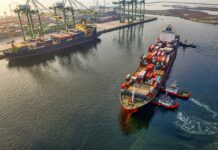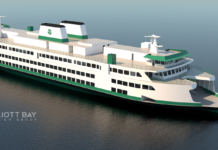
Container News recently chatted with John Schmitter, co-founder and chief commercial officer of RailState, a supply chain visibility provider monitoring the freight rail networks of Canada and parts of the United States.
[This question-and-answer session was edited for clarity]
Container News: There’s been quite a bit of a buzz lately around potential labor disruptions in Canada: rail union members at Canadian Pacific Kansas City (CPKC) and Canadian National (CN) are expected to go on strike on 22 August, while members of International Longshore and Warehouse Union Local 514 in Vancouver are still looking for a contract resolution. Meanwhile, in the United States, there are concerns about potential labor disruptions at East Coast and Gulf Coast ports. How do the ports and those who handle international intermodal (IM) volumes cope with these potential disruptions?
Schmitter: These things can change rapidly in days but the expectation now is for a Canadian rail strike in late August.
So, when it comes to how those handling international IM volumes will cope, on the Canadian side, we’re really talking about the scale of losses. A national railway strike and potential port shutdown isn’t something to manage around.
Western US ports will likely see diverted ships and then it’s a question of how long. The US network can handle additional volumes, but a protracted shutdown in Canada will be felt everywhere. While the US and Canadian railroads may have a small amount of available capacity, any large diversion of cargo will likely be more than US railroads can handle. Railroad capacity is mostly defined by the number of train crews and locomotives they make available. Crews especially cannot be increased in meaningful amounts in less than about six months. Once the strike is over, there also won’t be capacity to move all the backlogged volume that accumulated.
CN: Labor disruptions aside, what’s the expectation for the fall peak among those who handle international containers? Is there confidence that the rail network and the ports can handle grain volumes and intermodal?
Schmitter: I don’t think we can put labor disputes aside this year. At least not for Canada.
We saw an early peak season in Canada, especially for Canadian National. Container volumes through the western ports rose consistently starting at the beginning of the year. May was the highest volume container month on Canadian National that RailState has recorded (our Canadian data goes back more than two years). They increased intermodal train volume, ran longer trains, and still had containers sitting at Vancouver. Canadian National increased IM train volume further for a short time to clear a backlog at the port but that change in capacity was only temporary and those crews, locomotives and train slots were at least partially taken from other traffic. The system is not set up to have sustained, increased train volume on short notice.
We see that consistently when there are big disruptions, like last year’s port strike or climate-related disruptions, like the Jasper wildfire that shut down Canadian National’s mainline last month.
There may be a short-lived increase in volume but the system will return to typical volume levels.
If we have a national railway strike going into a big grain season and peak container movements, there’s going to be lost volume that won’t be made up.
CN: We’re 3-4 years out of the height of the Covid-19 pandemic. Have international intermodal container volumes in the U.S. and Canada returned to normal? Or have they never been normal, or are we in a new normal? How much are factors like the Red Sea disruptions affecting North American container volumes?
Schmitter: I’m with [North American intermodal expert] Larry Gross on this. He commented on intermodal numbers last year about a return to normal. His answer: “Way too soon to say…give it a few years.








